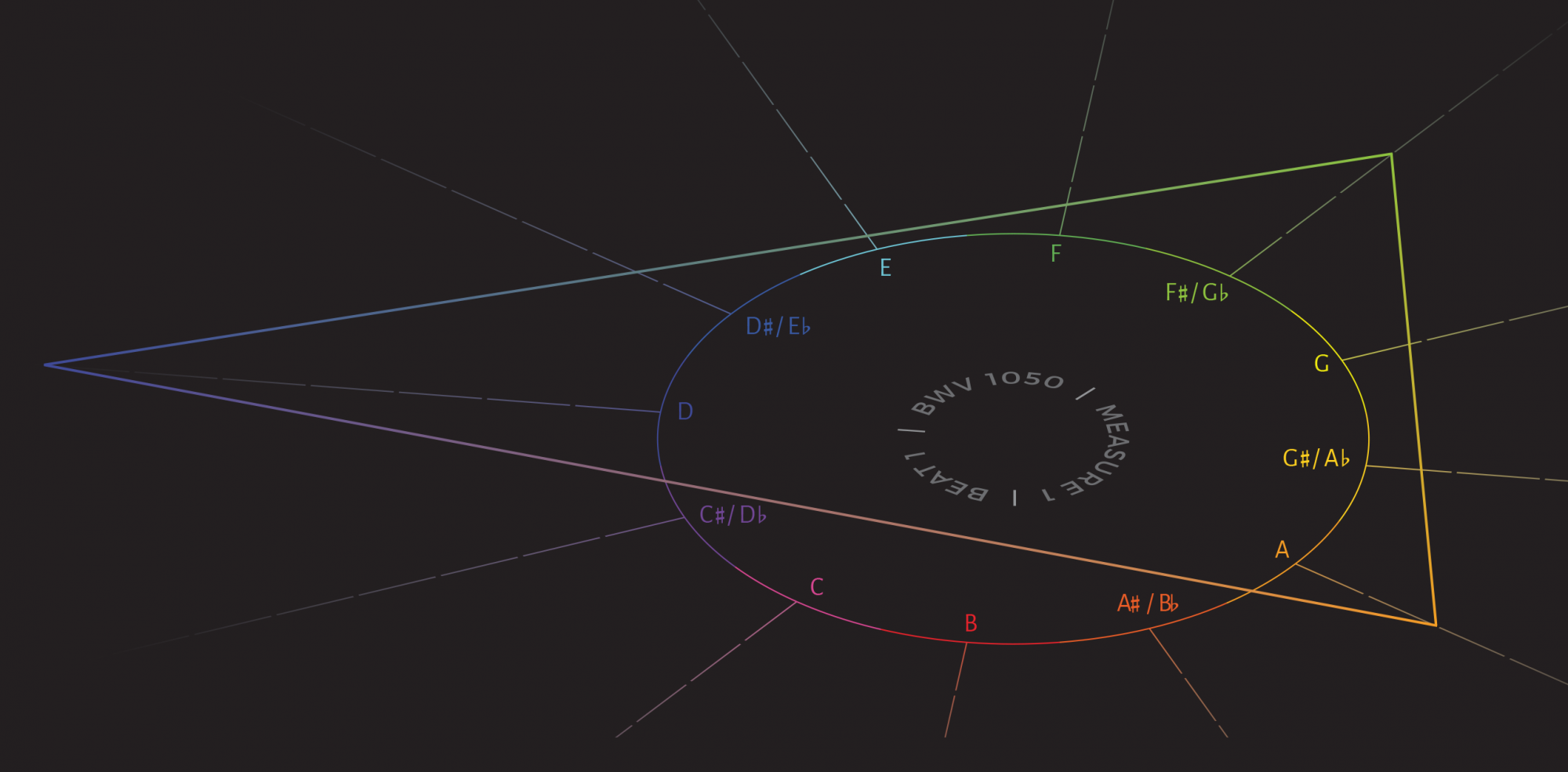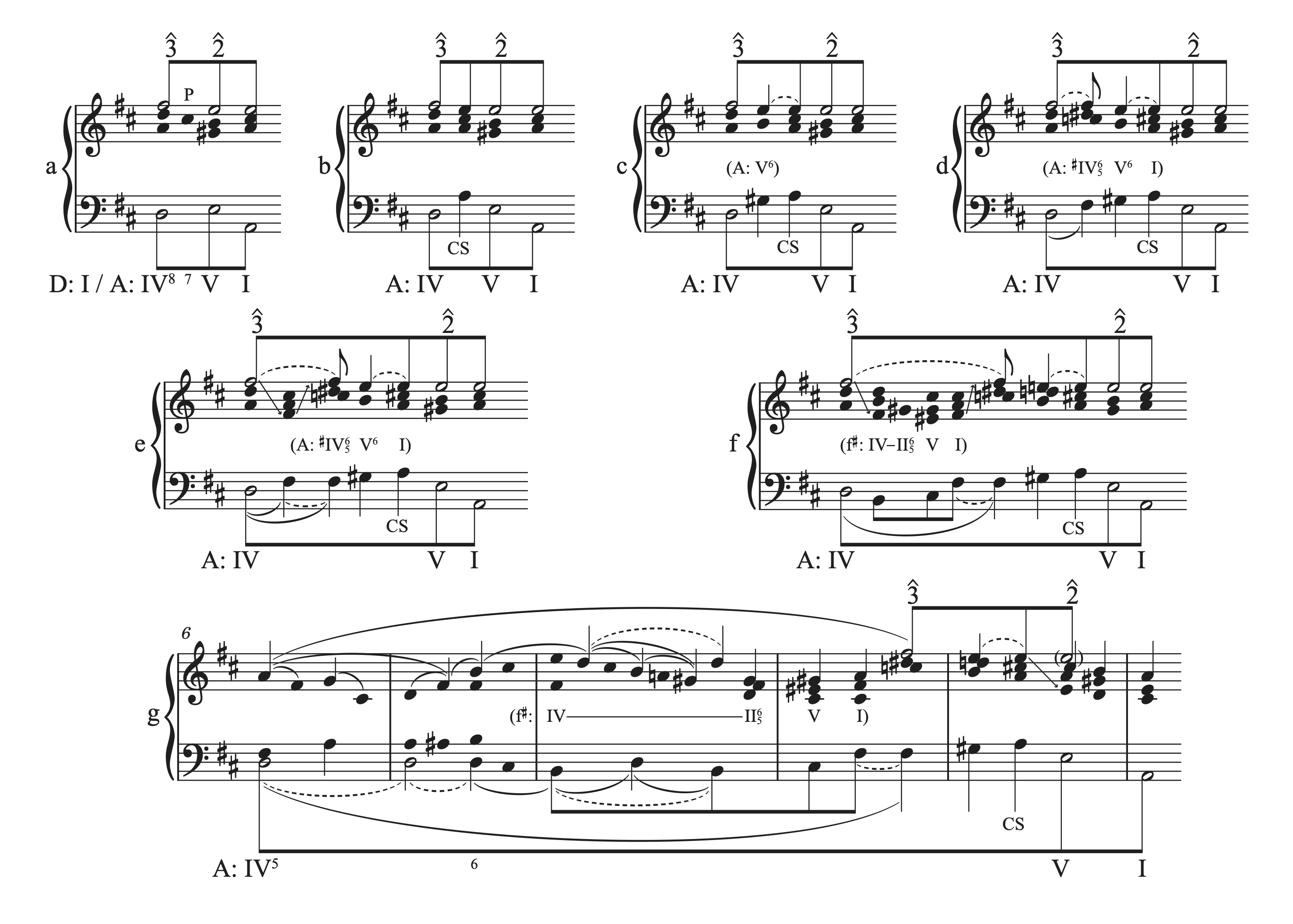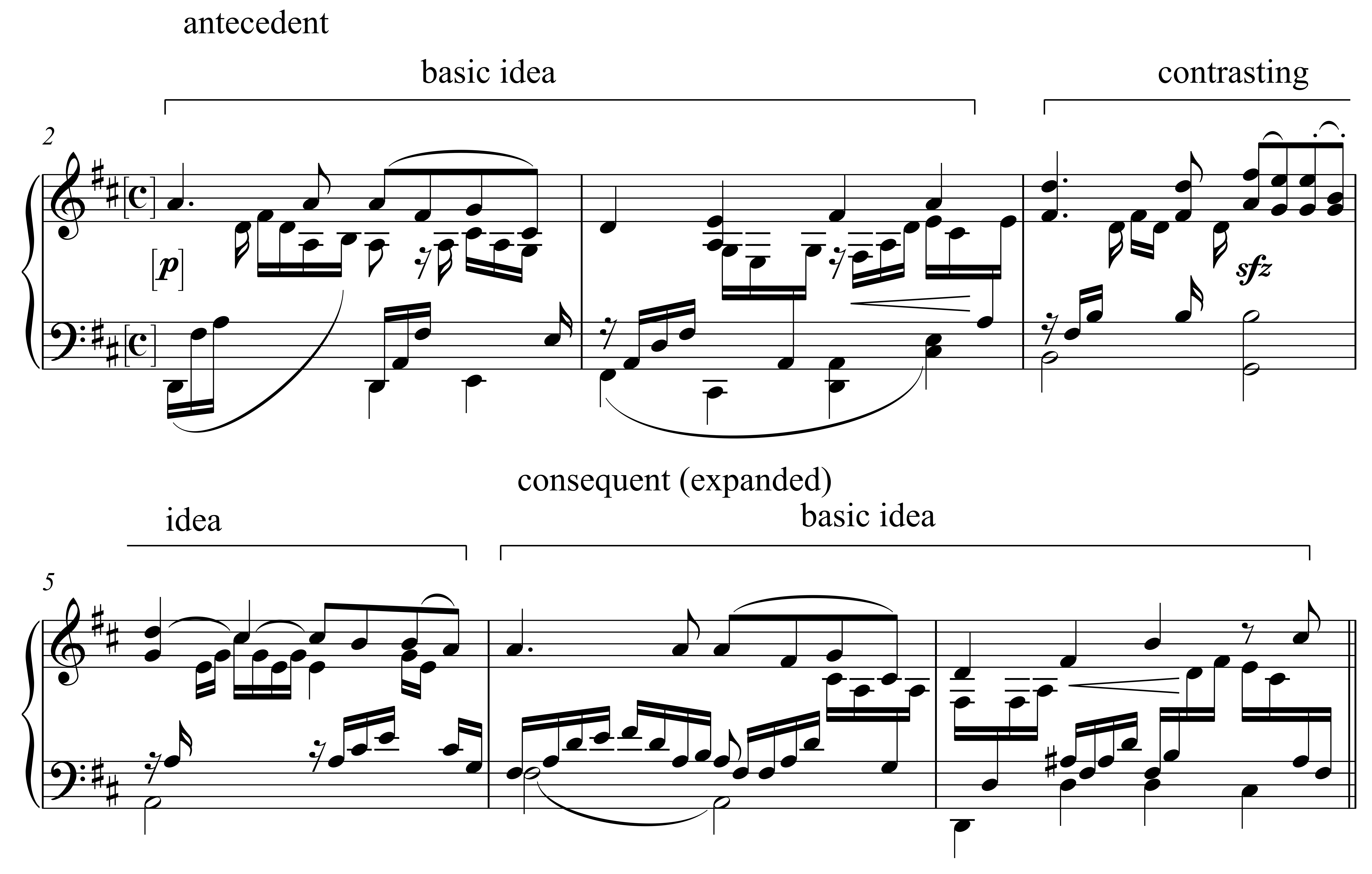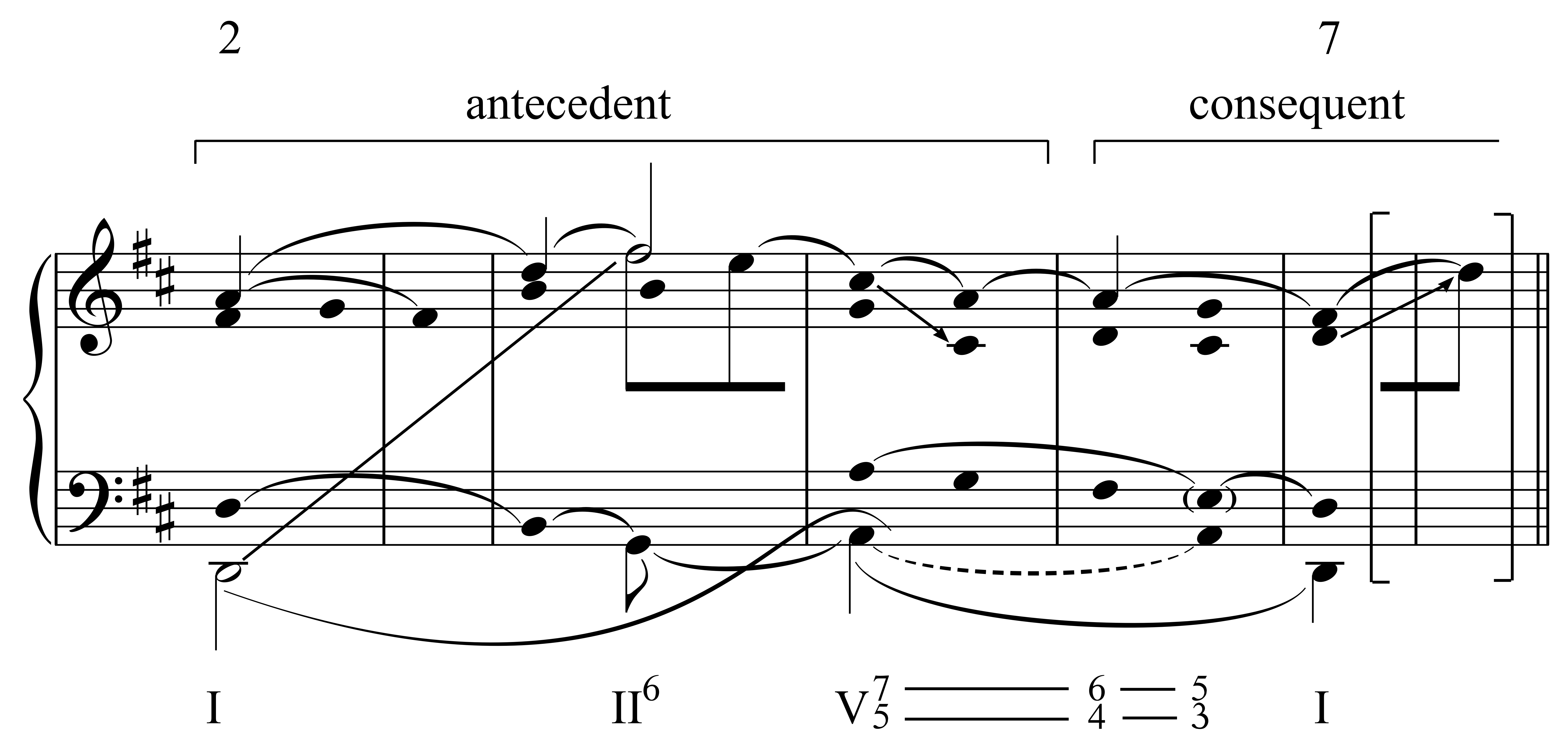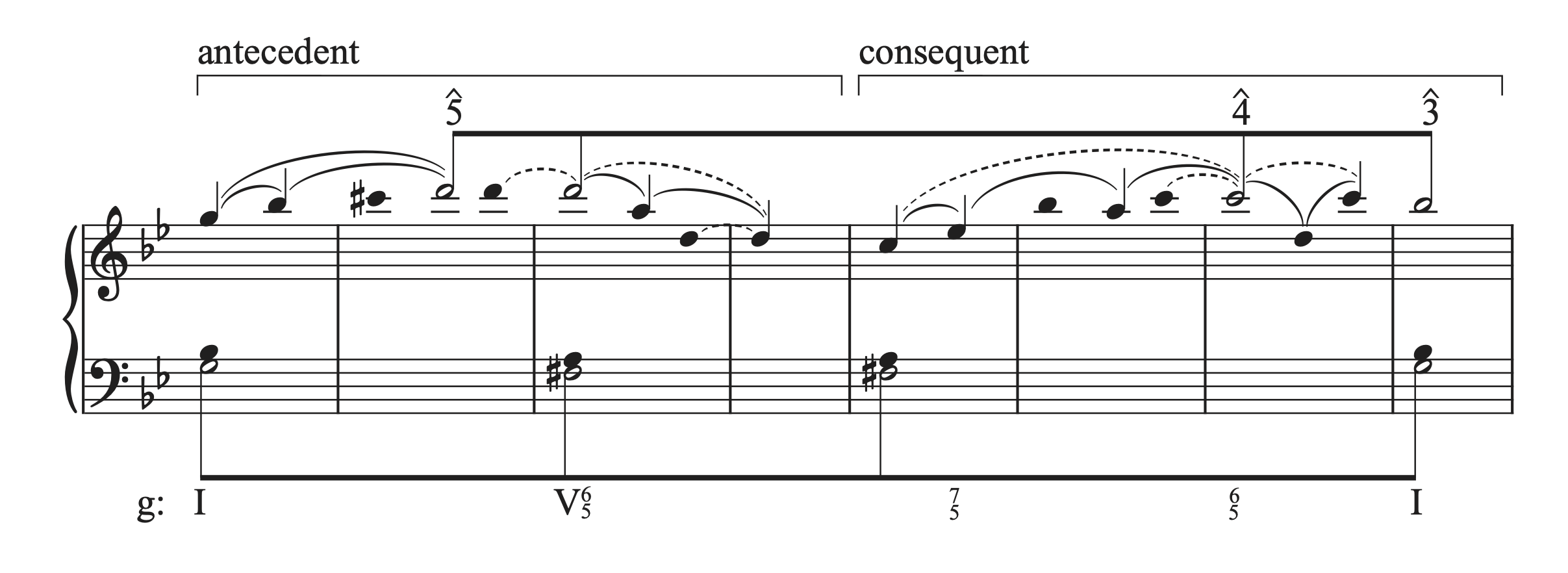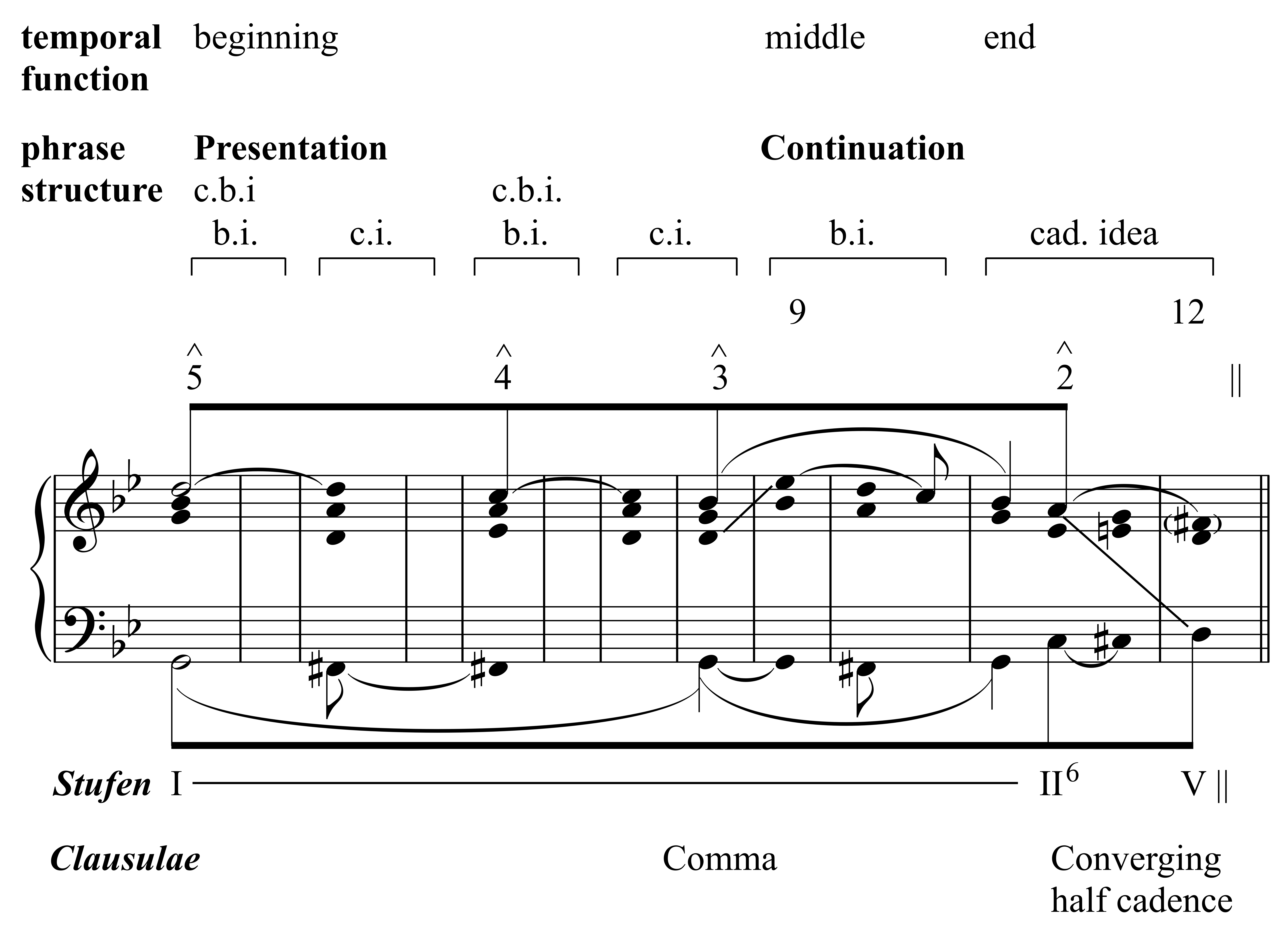Lauri Suurpää
View PDFSuggested Citation
Return to Volume 34
With Graphic Music Analysis, Eric Wen enters a densely-populated arena of Schenker-analytical textbooks. David Beach (2012; revised edition 2019) and David Damschroder (2017) have recently published Schenker guides, and the several older textbooks include those by Allen Forte and Steven Gilbert (1983) and by Allen Cadwallader and David Gagné, joined by Frank Samarotto in the fourth edition (2019). Although not a textbook, Carl Schachter’s recent The Art of Tonal Analysis: Twelve Lessons in Schenkerian Theory (2016) is a transcript of Schachter’s lessons given in 2012 at the CUNY Graduate Center, and the book’s orientation is clearly pedagogical. With such abundance of pedagogical material on Schenkerian analysis, is there still room for another textbook? With Wen’s book my answer is yes, because it brings a particular perspective to Schenkerian pedagogy that differs from other textbooks: its penetrating and exhaustive concentration on the interdependence and interaction among structural levels distinguishes it from other Schenkerian guides. As always with a book that includes numerous musical analyses, there are individual interpretations with which any given reader may disagree, or find even idiosyncratic, but the vast majority of Wen’s analyses are musical, technically flawless, and clearly presented. Throughout the book, one recognizes an experienced teacher, with the ability to communicate complex issues in clear examples and prose.
The book divides into four sections that gradually move from fundamentals of graphic analysis (Section 1) into more technical descriptions of the principles of Schenkerian analysis and its individual techniques (Sections 2 and 3). About one third of the book’s length is devoted to interactions between form and tonal structure (Section 4). The first three sections, and much of the fourth, address almost exclusively phrase-level events. Even a quick leafing through the examples shows that Wen’s emphasis is on local levels, which are often discussed in an exhaustive manner, while the broader organization of musical works is not examined as thoroughly. Entire musical works or even large-scale formal units are only analyzed in the final chapters (23–27). The companion web page includes a workbook, the scores and audio links for the pieces that Wen analyzes, as well as an explanation of Schenker’s analysis of the C-major Prelude from the first book of Bach’s Well-Tempered Clavier. The book’s organization and the material on the web page suit well the intended audience, “advanced undergraduates” and “graduate students” (xi), although some of the material may require more background than most undergraduate and many graduate students have.
Throughout the book, Wen’s pedagogical strategy is to subdivide musical units, often the length of a single phrase, into short excerpts that may be as short as a few bars only. He then meticulously clarifies, step by step, how the foreground structure of these segments derives from voice-leading patterns governing at deeper levels. There are often at least three or four structural levels that elucidate the voice leading of the short musical excerpts. Occasionally, Wen traces the origins of the excerpts’ voice-leading structure from strict counterpoint, in this way clarifying how an elaborate musical foreground is related to strict voice-leading procedures. The clarity with which Wen’s examples and verbal commentaries describe the rapport among structural levels is not only valuable for students; more experienced music theorists may also learn much about the interaction among structural levels. Indeed, sometimes the subtlety of the logic among the many layers may be thoroughly understood only by a reader with a deep knowledge of Schenkerian analysis.
This pedagogical strategy of emphasizing short excerpts is evident also in the workbook that is available on the accompanying web page. Here Wen gives all (or practically all) top-voice and bass pitches of excerpts covering a few measures, and the student’s task is to organize these pitches into structural and prolongational units. In his instructions, Wen points out issues that the student should take into account when working on the assignments. In the assignments for the final chapters of Section 4 on musical form, entire works are first subdivided into small segments. After having worked out foreground reductions on the segments, the student is asked to make middleground graphs of the whole.
***
Because Wen’s strategy of showing several gradually more complex structural levels of short excerpts is the one feature that most clearly distinguishes Graphic Music Analysis from other textbooks on Schenkerian analysis, I will start by discussing this approach, leaving the commentary on the book’s organization to a later point.
Stressing the inner organization of short excerpts has obvious pedagogical merits. The student gets a very clear idea of the rapport between structural levels, one of the key ideas in Schenkerian analysis. The relationships between harmony and counterpoint, another key idea, is elucidated in a way that is easy to comprehend. At the same time, detailed examination of short excerpts may occasionally make it more difficult for the student to grasp the larger structure as well as the role that the excerpts described in exhaustive detail play in this global context. In other words, there is a danger that the student may get the impression that the analysis of large structure can be arrived at by simply putting short excerpts one after the other. In order to elucidate these pros and cons, I will discuss Wen’s analysis of mm. 6–11 from Mendelssohn’s Song without Words, Op. 85, No. 4 (Ex. 1; Wen’s Ex. 25.21 on p. 300).
Wen examines this work in a section dedicated to periods with modulating consequents that constitute the opening A sections in a ternary form. When analyzing the modulating consequent (mm. 6–11), Wen shows seven layers that start with the simple skeleton shown at the (a) level—a IV–V–I progression in the dominant key, the opening global tonic reinterpreted as a IV in A major. The final layer (g) eliminates only the accompanimental figuration, retaining all top-voice pitches, bass notes, and harmonies that appear in the score. The student gets a very clear idea of a number of subtle technical issues: for example, the way in which a dissonant passing tone (level a) is given a consonant support (level b); the way in which a consonant sonority—a $$^{5}_{3}$$ sonority over F$$\sharp$$ (level e)—is subordinate to a dissonant sonority—a $$^{\sharp6}_{\natural5}$$ sonority over F$$\sharp$$ (level d); or the ways in which registral transfers and arpeggiations relate to stepwise progressions at deeper levels. The example preceding Ex. 25.21 (Ex. 1 in the present review) describes the antecedent (mm. 2–5), which, according to Wen, consists of “an interrupted Urlinie descent from $$\hat3$$ to $$\hat2$$” (299). Therefore, both the antecedent and the consequent end, in Wen’s reading, on a back-relating dominant.
Wen’s discussion of the Mendelssohn song is characteristic of the book’s pedagogical orientation. His analysis consists of 12 examples, ten of which show phrases (among them Ex. 25.21 shown as my Ex. 1), pairs of phrases, subphrases, or still shorter excerpts, while only two examples provide a more global view. The final example is an overview of the entire work and it receives a very brief verbal commentary. A context for the details is thus given only at the end, and the function of the shorter excerpts within this global context is not thoroughly discussed; for example, it is left for the reader to note that the latter of the two back-relating dominants in the opening period discussed above occurs at a deeper level than the former, a feature that might have had significance also for understanding the inner organization of the period. This mode of presentation characterizes Wen’s pedagogical approach. The short excerpts, often analyzed in great detail, are first discussed one after the other, and the larger context is provided at the end, often with only a brief commentary.
Yet a more thorough discussion of the ways in which the excerpts interact, and how the larger context may affect the interpretation of details, might give the student a more vivid picture of the music. As an example, let us return to the opening period of the Mendelssohn song and consider how the antecedent and consequent, which Wen discusses separately, might be seen to interact. Ex. 2 shows the score of the antecedent and the beginning of the expanded, modulating consequent. Although thematically identical, the beginnings of the antecedent and the consequent differ in their harmonic structure and figuration. The tonic of m. 2 is unequivocal, with a D2 heard in the bass on the first and third beats. Measure 6, by contrast, begins with the first inversion of the tonic, the F$$\sharp$$ on the first beat heard, moreover, in a higher register than the dominant that follows it on the third beat. In his analysis (Ex. 1), Wen acknowledges the first inversion and the relatively high F$$\sharp$$ only by placing the tonic pitch in parentheses at level (g) that shows the musical surface. At other layers, he simply shows a D in the bass.
If the consequent is studied in isolation, as Wen does, his reading is plausible. However, if the period is approached as a whole, there is a closer voice-leading connection between the antecedent and the consequent. This continuity is primarily suggested by the register of the bass, and the key to this reading is the hierarchy between the bass-pitches F$$\sharp$$3 and A2 in m. 6. Owing to the A2 heard already in m. 5, I would argue that the As in mm. 5 and 6 are structurally connected. The F$$\sharp$$3 that opens m. 6 in the bass, in turn, is prepared by a G3 in the preceding measure, so it sounds like an element in a stepwise inner-voice progression (A3–G3–F$$\sharp$$3) rather than as the arrival at the bass pitch of a new Stufe, a I6. Later, in m. 7, the D2 provides an unequivocal landing on the tonic, regaining the D2 sounded in m. 2.
Example 3 shows a graph clarifying this reading. I interpret the D-major six-three chord in m. 6 as a passing sonority within a prolonged dominant, as fundamentally a six-four chord above the A in the bass. Unlike Wen, I do not read a local interrupted $$\hat3$$–$$\hat2$$|| progression in the antecedent, but instead take the E5 as a passing tone within the third progression F$$\sharp$$–E–D.1 All in all, I would suggest that the phrase-structural boundary in m. 6 is bridged over by voice-leading continuity.2 I don’t mean to say that my reading is more “correct” than Wen’s, or even that it is better in any demonstrable sense. What I do maintain, however, is that my reading can’t be arrived at unless one considers the opening period as one voice-leading entity. A strict division of the music into an antecedent and a consequent—segments that Wen treats as quasi-independent entities—prevents the student from considering these kinds of continuous voice-leading processes.3
I have spent so much time on one example because it clarifies both the pedagogical merits and challenges in Wen’s strategy of often concentrating on detailed discussion of relatively short musical excerpts. The merits of this approach are evident throughout the book. By studying the interactions among structural levels in short excerpts, the student gets a clear, thorough, and consistently-explained view of the tonal structure. The Mendelssohn example is one of the numerous I could have chosen for showing this. At the same time, there is a danger of giving a somewhat pointillistic picture of the musical structure; in other words, the student may get the impression that the larger structure can be arrived at by assembling relatively independent musical excerpts one after the other. In this respect, the Mendelssohn example is an extreme case in Wen’s book; I have consciously chosen an example that clearly indicates the discrepancy between the independence of local segments and the global continuity. In fact, Wen often elucidates ways in which consecutive segments create larger structural arches; as an example, the discussion of the opening nine measures of Brahms’s First Symphony (87–92) clarifies relationships and apparent tension between local impressions of fleeting keys and more global prolonged Stufen.
The interaction between details and the larger context addresses one recurring challenge in teaching Schenkerian analysis: if one emphasizes details, the global perspective as a framework may remain unspecified or at least undervalued; on the other hand, if one concentrates on middleground structure, especially a newcomer to Schenkerian analysis may not be able to follow the logic with which the deeper levels have been inferred from the surface. Wen’s decision is clearly to emphasize analysis of details.
***
Graphic Music Analysis is organized in a way that makes it easy for the student to understand the complex and subtle aspects of tonal structure—and for the teacher to explain them. As mentioned, the book divides into four sections. The first section (Graphic Music Analysis) mainly concentrates on graphic notation, linear progressions, and the idea of hierarchy. Here Wen’s strategy of concentrating on short excerpts works well; carefully chosen examples and clearly-illustrated structural levels gradually introduce ways in which individual pitches belong together and constitute structural, prolongational units. Wen ends the first section in an extended and very detailed discussion of the first-movement introduction of Mozart’s “Dissonance” Quartet. It is wise not to introduce many Schenkerian concepts and techniques in this opening section. The student learns the basics of tonal structure and graphic notation without having to cope with many new terms.
The second section (Semper idem, sed non eodem modo) directly addresses Schenkerian analysis with a chapter on the concept of Ursatz and a chapter each for Urlinie descents from $$\hat3$$ and from $$\hat5$$. All of Wen’s examples in this part consist of phrase-level Ursatz replicas; thus the emphasis is on local phenomena. This is pedagogically sensible; Wen can introduce the idea of tonally closed and independent structural entities without losing sight of the details that constitute such units. In this way, the student begins to understand self-contained structural units and how they are related to the foreground. It is also helpful to introduce stricter analytical graphics only here, after first having addressed issues of tonal structure in Part 1 in a somewhat more informal manner. Again, the analyses are convincing, verbal clarifications clear, and the examples well chosen.
The third section (Techniques of Elaborating the Ursatz) concentrates on individual Schenkerian techniques; in particular, ones that elaborate the governing Ursatz. Wen clarifies techniques like substitution, delaying the initial tone of the Urlinie, implied tones, mixture, and auxiliary cadence. As in the preceding section, Wen treats Ursatz replicas that occur at the phrase level. Together, the first three sections address most of the primary Schenkerian techniques through musical examples and analytical prose. Many of the techniques also appear in the chapter headings. Thus, the table of contents, with additional help coming from the index, guides students to the principal techniques of Schenkerian analysis.
As comprehensiveness is not possible in any textbook, some techniques must be emphasized more than others. In Graphic Music Analysis, unfolding and reaching-over are discussed only in passing.4 As students will unavoidably encounter both techniques when working on voice-leading graphs, they would merit their own chapters alongside the other techniques. In my own experience, both concepts are quite difficult to grasp, in part owing to the complex interaction among individual parts of the imaginary continuo.
The auxiliary cadence is one of the Ursatz-elaborating techniques that Wen discusses in Section 3 (Chapter 19). As his definition of this concept somewhat differs from the standard application, I will briefly comment on his view. Wen uses this concept when a “succession of chords. . . is used to make a nontonic chord or key area sound like a temporary tonic” (203).5 In Wen’s analyses, transformations of a nontonic chord into a temporary tonic often occur when the music modulates to the dominant key. In these instances, Wen suggests a retrospective reinterpretation of the structural tonic as a IV in the dominant key; in other words, the structural tonic functions as a deep-level “pivot” (205) initiating an auxiliary cadence. This view differs from Schenker’s definition of the auxiliary cadence, in which the chords preceding the goal tonic “are related only to the forthcoming I; they point only to it” (Schenker [1935] 1979, 88). That is, Schenker sees the chord that begins the auxiliary cadence to be cut off from the preceding music; it is only related to the tonic (either global or local) that ends the auxiliary cadence, thus having a kind of anticipatory function.
According to Wen’s definition, anticipation is not required in an auxiliary cadence as Schenker’s definition implies and as William Rothstein’s (1981, 122–128) and Edward Laufer’s (1999, 135–137) descriptions explicitly state.6 Wen’s view on the auxiliary cadence can be seen in Ex. 1 above, of which he writes “[l]evel a shows how the dominant key is established by an auxiliary cadence in which the original D-major tonic functions as IV in A major” (301). That is, he takes the opening D-major triad as a pivot (D: I = A: IV), thus disregarding Schenker’s view that the sonorities constituting the auxiliary cadence are structurally connected only to the forthcoming tonic.
The deep-level pivot chord is also applied in the book’s fourth and final section on interactions between voice leading and form (Tonal Structure and Musical Form). For example, Wen writes of the exposition in the F-major slow movement of Mozart’s Jupiter Symphony that “[b]y regarding the opening tonic as IV in the key of C major, the augmented-sixth chord in bar 28 represents a transformation of this stable IV into an active leading-tone chord” (319). In his Example 26.17 that shows mm. 1–28 of the movement, Wen labels the opening tonic as IV in the dominant key. While I agree with Wen’s interpretation of a chromaticized voice exchange, I find it musically counterintuitive to label the opening tonic as a IV in the dominant key. I would prefer to call the opening sonority only the tonic—that is the chord’s unequivocal impression, after all—and follow Carl Schachter’s (1999, 137) idea that the “tonal center of a passage may change during the prolongation of a single harmony.” That is, the opening chord is a tonic in the key of F major while the augmented-sixth chord that ends the voice exchange occurs in the key of C major. This idea might also be easier to grasp for students, who may not hear the opening tonic sonority as belonging to the forthcoming dominant key. Such interpretations of the opening tonic as a IV in the dominant key occur often in the book.
Wen starts Section 4 with periods and moves via ternary form to the concluding discussion of sonata form. The chapters on ternary form mainly address the inner organization of, as well as the differences between, the two A sections. He discusses the voice leading in the contrasting B sections either briefly or not at all. The chapter on sonata form includes an extended and detailed discussion of one major-mode movement (the slow movement of Mozart’s Jupiter Symphony referred to above) and one minor-mode work (the first movement of Beethoven’s Appassionata Sonata). Here, for the first time, Wen analyzes entire pieces, showing the student how Schenkerian analysis operates in describing global structure. This is rather late in the book to address tonal structure in entire works; Ex. 23.5 is the first graph showing the structure of a whole piece (252). In the two analyses of entire sonata-form movements, the largest part is again devoted to examination of short excerpts, but here Wen also devotes some space to discuss the global structure towards the end of the two analyses. He also shows and discusses in some detail paradigmatic sonata-form patterns.
Wen does not contextualize or clarify in detail his approach to musical form. Although briefly referring to William Caplin’s (1998) functional theory of Classical form and to Sonata Theory by James Hepokoski and Warren Darcy (2006), he does not use these or other recognized approaches for describing formal organization in any comprehensive manner, apart from frequent references to the “medial caesura.” Wen’s undertheorized approach to form makes it occasionally difficult to follow his elucidations of the interactions between form and tonal structure. His usage of the terms “phrase” and “parallel period” is a case in point. The definitions of these terms are very flexible. A phrase may be either “open” or “closed” (219). (Wen does not explain his usage of the terms “open” and “closed,” however; he probably means either that phrases may or may not end in a cadence, or that only a perfect authentic cadence suffices to “close” a phrase.) The parallel period, then, pairs two such phrases, which “have something equivalent to each other” (ibid.). This tentative definition of the parallel period differs from the common usage of this term, which is strongly based on cadential punctuation; such a usage appears both in the Formenlehre tradition (e.g., Caplin 1998, 49–58) and in Schenkerian discussions of form (e.g., Rothstein 1989, 16–18; and Beach 2012, 40–56). Indeed, Wen mostly, but not always, discusses parallel periods organized by clear cadential punctuation, and also mentions the organizational role cadences play (220). However, his examples of periods without cadences are problematic as elucidations of the rapport between form and tonal structure.
As Wen does not take cadential conclusion as a defining feature of a parallel period, it is not possible to define whether the parallel periods he discusses are formally and tonally independent units—in the cases which do not end in a cadence, some continuation is required in order to reach a functional conclusion and a tonal goal. This uncertainty relates directly to the question of interrelationships between details and context; attempting to analyze periods lacking cadential closure outside of the larger context gives only a partial view of the interactions between voice leading and form. An example occurs in the section examining “parallel periods with a symmetrical tonal structure” (238–241). Wen uses this term when referring to pairings of phrases with a harmonic structure I–V, V–I. From William Caplin’s form-functional perspective of phrase structure, at least some of the parallel periods that Wen discusses under this rubric would be interpreted as presentations within larger sentential structures, and would thus not represent parallel periods; that is, closed form-functional units. Wen acknowledges this, stating that “whether or not these periods serve as a ‘presentation’ within a larger thematic construction in no way precludes partitioning and understanding them as tonal entities by themselves” (241). Wen is of course right in maintaining that it is possible to examine such segments as independent units. However, I am not convinced that understanding presentations “as tonal entities by themselves” helps to clarify interactions between tonal structure and form, the topic addressed in Section 4 of Graphic Music Analysis.
In order to substantiate my doubts, I refer to Wen’s interpretation of the opening of Haydn’s Symphony No. 83, which appears in the section on “parallel periods with a symmetrical tonal structure.” Ex. 4 (Ex. 22.6 on p. 239) is Wen’s analysis of mm. 1–8, which he interprets as a parallel period. In the “antecedent,” the graph shows a motion from the tonic to a V$$^{6}_{5}$$ chord, while the “consequent” leads the music back to the tonic.7 The top voice, in turn, shows a $$\hat{5}$$–$$\hat{4}$$–$$\hat{3}$$ progression, with the $$\hat{4}$$ functioning as a passing tone supported by the dominant. Wen is correct in maintaining that this passage can be understood as a tonal entity in itself; harmonically it closes on the tonic, while the top voice consists of a tonic-prolonging third-progression. Yet it does not constitute, in my opinion, a musically meaningful form-functional unit. Part of the reason is that the dominant occurs only in first inversion; thus, there is no proper cadential arrival to indicate a tonal closure.
Example 5 shows a larger context for mm. 1–8. As I completely agree with Wen’s interpretation of the voice-leading structure of mm. 1–8, my graph of these measures is identical to his, only clarifying a somewhat deeper level. In the lowermost line of Ex. 5, I show two harmonic resting points, or clausulae, labeling them according to Robert O. Gjerdingen’s terminology (2007). Wen’s parallel period concludes in m. 8 with a V$$^{6}_{5}$$–I progression, or in Gjerdingen’s terminology, a “Comma”: a resting point that provides the music only with a weak sense of closure. From the perspective of voice leading, the dominant occurs in first inversion, built above a neighboring F$$\sharp$$ in the bass, so V is not a proper Stufe but rather a neighboring, contrapuntal sonority. Owing to the lack of deeper-level harmonic motion, I interpret mm. 1–8 as a beginning of a larger musical unit, a presentation in a compound sentence (see the lines “temporal function” and “phrase structure” in Ex. 5).8As a result, rather than interpreting an antecedent and a consequent as Wen does, I read a repeated compound basic idea, a signal of an initiation of a larger phrase-structural entity. As m. 8 only concludes the initial phase of a larger formal unit, I do not take the top-voice $$\hat3$$ of this measure as a conclusion of an independent third progression either, but rather as a member of a fourth-progression that continues one step further to a $$\hat2$$ (mm. 11–12). This $$\hat2$$ is first supported by a II6 and then by a back-relating dominant. The arrival at the dominant is enhanced by a “Converging half cadence,” a resting point that is much stronger than the Comma in m. 8, and one that suffices to provide the music with a functional, cadential conclusion.
I do not question the plausibility of Wen’s voice-leading analysis shown in Ex. 4; on the contrary, I completely agree with it. However, I find it musically counterintuitive to understand mm. 1–8 as a parallel period. If the intent is to discuss interactions between form and voice-leading structure, analysis of mm. 1–8 as an independent unit gives only a partial view on the rapport between form and tonal structure. To be sure, Ex. 4 and its commentary explain voice leading well if this segment is considered outside of its musical context. However, Ex. 4 does not clarify how tonal structure may help to locate formal boundaries, for example, or, at a general level, which elements of tonal structure have an effect on interpretation of form. As a result, this example (and others like it) does not much deepen, in my opinion, the student’s understanding of the interactions between form and tonal structure.
***
The orientation of Graphic Music Analysis is more analytical than theoretical, and all techniques are introduced as they appear in the pieces that Wen examines. The student thus learns general principles of tonal structure and particular details of Schenkerian analysis through Wen’s observations. With the detailed nature of the analyses, the principles of Schenkerian analysis and the pertinent concepts are thoroughly explained. The exhaustive manner in which numerous short excerpts are analyzed at a number of structural levels distinguishes Graphic Music Analysis from other textbooks on Schenkerian analysis. Yet, the rapport between musical details and their larger context is not always clarified as thoroughly as it might have been; this point concerns both structural relationships between independently-examined short excerpts (as in the Mendelssohn song) and interrelationships between form and tonal structure (as in the Haydn symphony). But I assume that not everyone will find the emphasis on short excerpts problematic; teachers willing to concentrate on local levels of tonal structure will value emphasis on short musical segments.
As there is no one correct approach to Schenkerian pedagogy, the unique orientation of Graphic Music Analysis makes it a valuable contribution to the pedagogical material on Schenkerian analysis. In particular, teachers and students willing to study tonal structure of shorter musical segments in penetrating detail will find Graphic Music Analysis an excellent guide.
Lauri Suurpää
Sibelius Academy, University of the Arts Helsinki
PO Box 30, FI-00097 Uniarts, Finland
lauri.suurpaa@uniarts.fi
References
Beach, David. 2012. Advanced Schenkerian Analysis: Perspectives on Phrase Rhythm, Motive, and Form. New York: Routledge.
Burstein, Poundie. 2005. “Unraveling Schenker’s Concept of the Auxiliary Cadence.” Music Theory Spectrum 27 (2): 159–85.
Cadwallader, Allen, David Gagné, and Frank Samarotto. 2019. Analysis of Tonal Music: A Schenkerian Approach, fourth edition. New York: Oxford University Press.
Caplin, William. 1998. Classical Form: A Theory of Formal Functions for the Instrumental Music of Haydn, Mozart, and Beethoven. New York: Oxford University Press.
Damschroder, David. 2017. Tonal Analysis: A Schenkerian Perspective. New York: Norton.
Forte, Allen, and Steven E. Gilbert. 1982. Introduction to Schenkerian Analysis. New York: Norton.
Gjerdingen, Robert O. 2007. Music in the Galant Style. New York: Oxford University Press.
Hepokoski, James and Warren Darcy. 2006. Elements of Sonata Theory: Norms, Types, and Deformations in the Late-Eighteenth-Century Sonata. New York: Oxford University Press.
Laufer, Edward. 1999. “On the first movement of Sibelius’s Fourth Symphony: A Schenkerian View.” In Schenker Studies 2, ed. Carl Schachter and Hedi Siegel, 127–59. Cambridge: Cambridge University Press.
Rothstein, William. 1981. Rhythm and the Theory of Structural Levels.” Ph.D. diss, Yale University.
———. 1989. Phrase Structure in Tonal Music. New York: Schirmer Books.
Schachter, Carl. 1999. Unfoldings: Essays in Schenkerian Theory and Analysis. Ed. Joseph N. Straus. New York: Oxford University Press.
———. 2016. The Art of Tonal Analysis: Twelve Lessons in Schenkerian Theory. Ed. Joseph N. Straus. New York: Oxford University Press.
Schenker, Heinrich. [1935] 1979. Free Composition. Trans. and ed. Ernst Oster. New York: Longman.
Notes
- Registrally, this F$$\sharp$$–E–D progression reaches its concluding D5 only in m. 8, when the harmony has already arrived at a B-minor triad, resulting from a 5–6 progression above D. (This harmonic progression is not shown in Ex. 2.) The arrows in Ex. 3 indicate the shift of the top voice into an inner voice and back to the treble.
- This kind of bridging over, where a thematic return occurs in the middle of a tonal progression, is a device that Mendelssohn frequently used. When discussing Mendelssohn’s Songs without Words, William Rothstein (1989, 192) has applied the term “deceptive recapitulation of a principle theme” when referring to a situation in which “a thematic motive, which initially formed the beginning of a phrase, returns in the middle of a phrase—trying but not succeeding, as it were, to appear like its old self.” Rothstein speaks about overall form, but at the subphrase level the same principle can be applied to the return of the initial basic idea that opens the consequent.
- Elsewhere, Wen is sensitive to voice-leading continuities transcending formal boundaries, writing that “the voice-leading structure can sometimes bridge across both phrases of a period” (249).
- The relative sparseness of Wen’s descriptions of reaching-over may be due to the fact that he defines this technique in a somewhat narrower way than Schenker does. For Wen, reaching-over refers to a “two-note descending figure” (361) while Schenker refers to “a group of at least two descending tones” (Schenker [1935] 1979, 47; italics added).
- Wen is not quite consistent with his requirement of the need of an auxiliary cadence to confirm a nontonic key, however, although he states this requirement twice (203, 359). When discussing the opening theme of the Finale of Mozart’s Piano Concerto, K. 453, he interprets a harmonic progression starting on I6 as an auxiliary cadence (207), even though the progression ends on the home-key tonic. See also Ex. 25.40 (306).
- Poundie Burstein (2005, 164–167) notes that Schenker’s emphasis on the primacy of “the forthcoming I” does not always lead to anticipatory metrical structures in the analytical applications appearing in Der freie Satz.
- As there is no C (the seventh) in mm. 3–4, a more correct harmonic label in these measures would be V6 rather than the V$$^{6}_{5}$$ that Wen shows.
- William Caplin (1998, 69–70) has a similar analysis of the phrase structure; the only difference between his interpretation and mine is that he does not show the inner subdivision of the continuation.
